La Trobe University: Epidemiology Assignment on Respiratory Health
VerifiedAdded on 2022/10/17
|10
|2481
|39
Homework Assignment
AI Summary
This assignment presents a student's comprehensive analysis of an epidemiological study examining respiratory health in Aboriginal and Torres Strait Islander children within the Australian Capital Territory. The assignment addresses key aspects of the study, including the research question, study design (a two-stage questionnaire survey), and its appropriateness. It critically evaluates the impact of sample sizes on the study's quality, considering potential biases arising from the disparity in sample sizes between the indigenous and non-indigenous groups. The student also assesses the response rates and their implications for the study's representativeness and validity. Furthermore, the assignment explores potential sources of selection and measurement bias, identifies the primary exposure and outcome variables (respiratory symptoms, parent-reported asthma, hay fever, and wheeze), and discusses the methods used to measure asthma prevalence. The student also evaluates the study's control for confounders, the presence of statistical power, and the presentation of confidence intervals and p-values. The assignment culminates in a summary of the major findings, highlighting the higher prevalence of respiratory symptoms in Indigenous children, and a critical assessment of the study's overall value and quality, considering factors like sample size, measurement error, selection bias, and statistical power, and providing recommendations for improvements.
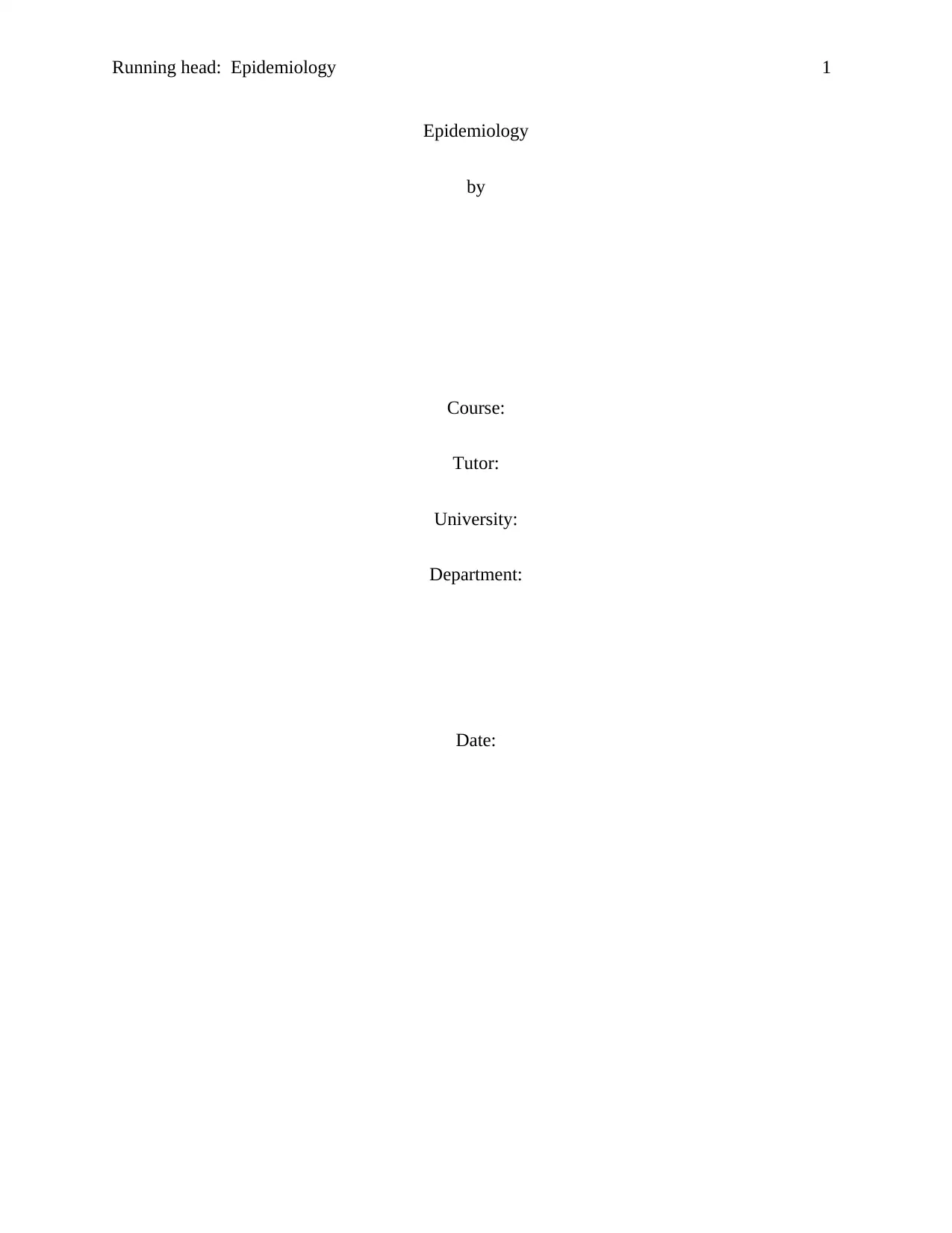
Running head: Epidemiology 1
Epidemiology
by
Course:
Tutor:
University:
Department:
Date:
Epidemiology
by
Course:
Tutor:
University:
Department:
Date:
Paraphrase This Document
Need a fresh take? Get an instant paraphrase of this document with our AI Paraphraser
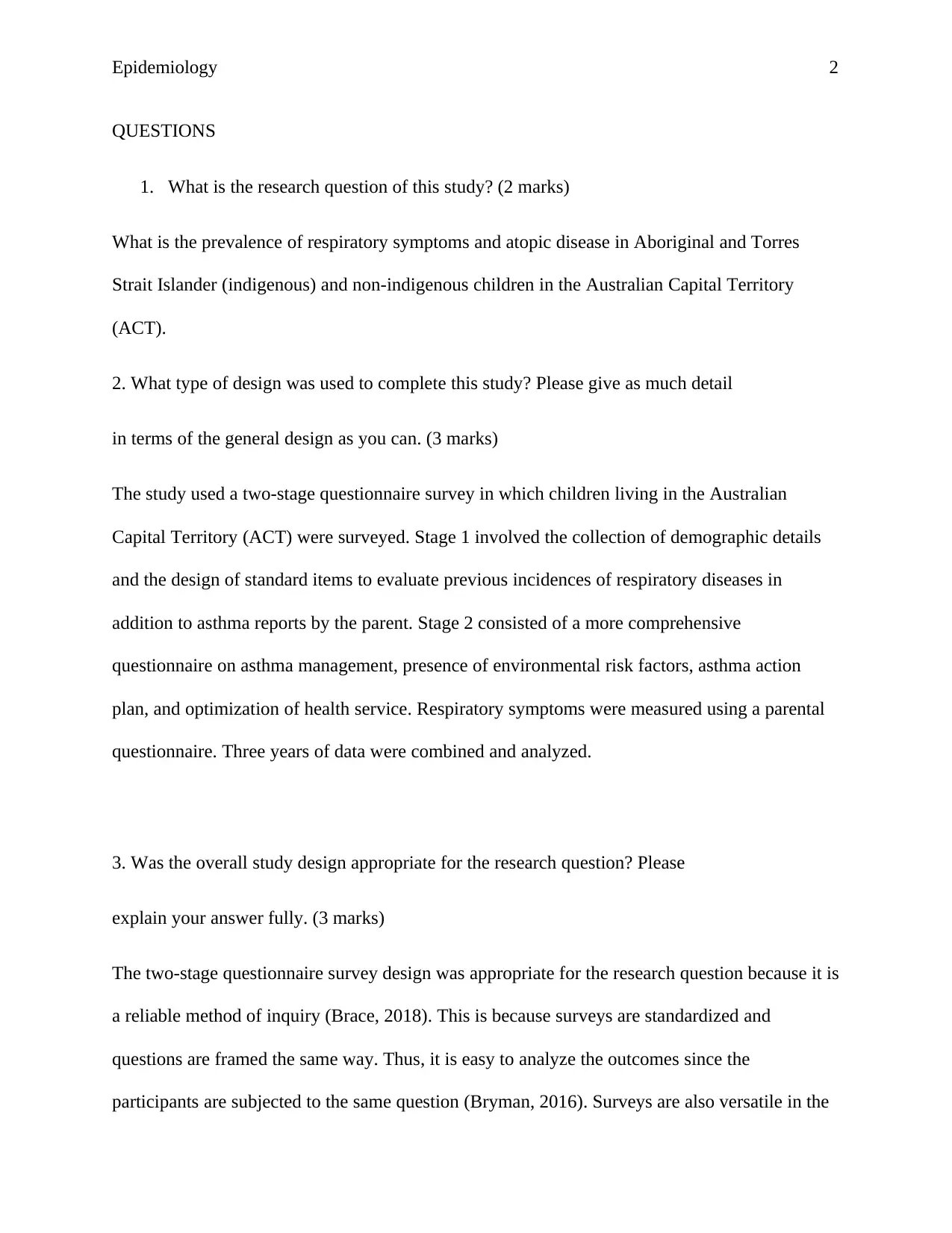
Epidemiology 2
QUESTIONS
1. What is the research question of this study? (2 marks)
What is the prevalence of respiratory symptoms and atopic disease in Aboriginal and Torres
Strait Islander (indigenous) and non-indigenous children in the Australian Capital Territory
(ACT).
2. What type of design was used to complete this study? Please give as much detail
in terms of the general design as you can. (3 marks)
The study used a two-stage questionnaire survey in which children living in the Australian
Capital Territory (ACT) were surveyed. Stage 1 involved the collection of demographic details
and the design of standard items to evaluate previous incidences of respiratory diseases in
addition to asthma reports by the parent. Stage 2 consisted of a more comprehensive
questionnaire on asthma management, presence of environmental risk factors, asthma action
plan, and optimization of health service. Respiratory symptoms were measured using a parental
questionnaire. Three years of data were combined and analyzed.
3. Was the overall study design appropriate for the research question? Please
explain your answer fully. (3 marks)
The two-stage questionnaire survey design was appropriate for the research question because it is
a reliable method of inquiry (Brace, 2018). This is because surveys are standardized and
questions are framed the same way. Thus, it is easy to analyze the outcomes since the
participants are subjected to the same question (Bryman, 2016). Surveys are also versatile in the
QUESTIONS
1. What is the research question of this study? (2 marks)
What is the prevalence of respiratory symptoms and atopic disease in Aboriginal and Torres
Strait Islander (indigenous) and non-indigenous children in the Australian Capital Territory
(ACT).
2. What type of design was used to complete this study? Please give as much detail
in terms of the general design as you can. (3 marks)
The study used a two-stage questionnaire survey in which children living in the Australian
Capital Territory (ACT) were surveyed. Stage 1 involved the collection of demographic details
and the design of standard items to evaluate previous incidences of respiratory diseases in
addition to asthma reports by the parent. Stage 2 consisted of a more comprehensive
questionnaire on asthma management, presence of environmental risk factors, asthma action
plan, and optimization of health service. Respiratory symptoms were measured using a parental
questionnaire. Three years of data were combined and analyzed.
3. Was the overall study design appropriate for the research question? Please
explain your answer fully. (3 marks)
The two-stage questionnaire survey design was appropriate for the research question because it is
a reliable method of inquiry (Brace, 2018). This is because surveys are standardized and
questions are framed the same way. Thus, it is easy to analyze the outcomes since the
participants are subjected to the same question (Bryman, 2016). Surveys are also versatile in the
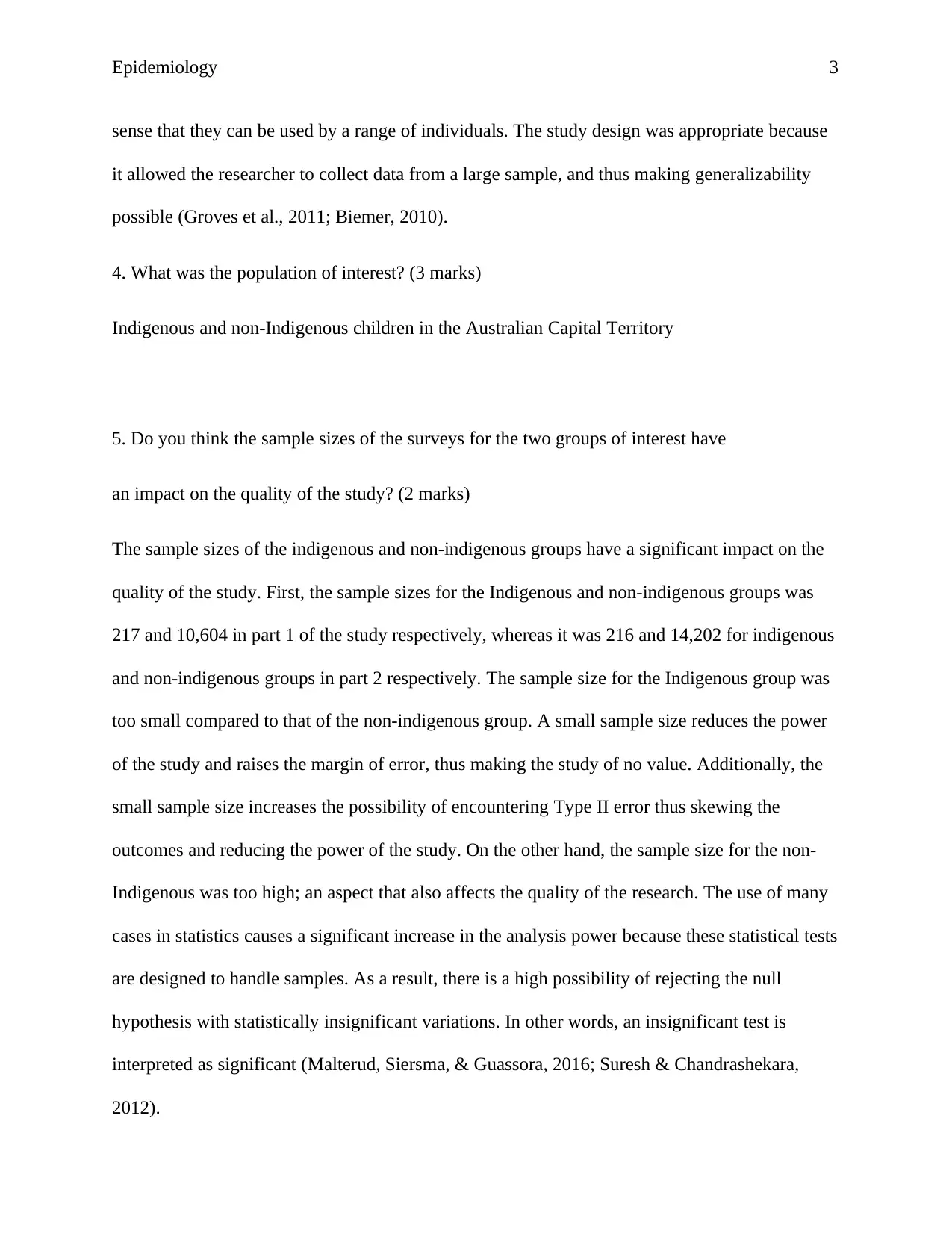
Epidemiology 3
sense that they can be used by a range of individuals. The study design was appropriate because
it allowed the researcher to collect data from a large sample, and thus making generalizability
possible (Groves et al., 2011; Biemer, 2010).
4. What was the population of interest? (3 marks)
Indigenous and non-Indigenous children in the Australian Capital Territory
5. Do you think the sample sizes of the surveys for the two groups of interest have
an impact on the quality of the study? (2 marks)
The sample sizes of the indigenous and non-indigenous groups have a significant impact on the
quality of the study. First, the sample sizes for the Indigenous and non-indigenous groups was
217 and 10,604 in part 1 of the study respectively, whereas it was 216 and 14,202 for indigenous
and non-indigenous groups in part 2 respectively. The sample size for the Indigenous group was
too small compared to that of the non-indigenous group. A small sample size reduces the power
of the study and raises the margin of error, thus making the study of no value. Additionally, the
small sample size increases the possibility of encountering Type II error thus skewing the
outcomes and reducing the power of the study. On the other hand, the sample size for the non-
Indigenous was too high; an aspect that also affects the quality of the research. The use of many
cases in statistics causes a significant increase in the analysis power because these statistical tests
are designed to handle samples. As a result, there is a high possibility of rejecting the null
hypothesis with statistically insignificant variations. In other words, an insignificant test is
interpreted as significant (Malterud, Siersma, & Guassora, 2016; Suresh & Chandrashekara,
2012).
sense that they can be used by a range of individuals. The study design was appropriate because
it allowed the researcher to collect data from a large sample, and thus making generalizability
possible (Groves et al., 2011; Biemer, 2010).
4. What was the population of interest? (3 marks)
Indigenous and non-Indigenous children in the Australian Capital Territory
5. Do you think the sample sizes of the surveys for the two groups of interest have
an impact on the quality of the study? (2 marks)
The sample sizes of the indigenous and non-indigenous groups have a significant impact on the
quality of the study. First, the sample sizes for the Indigenous and non-indigenous groups was
217 and 10,604 in part 1 of the study respectively, whereas it was 216 and 14,202 for indigenous
and non-indigenous groups in part 2 respectively. The sample size for the Indigenous group was
too small compared to that of the non-indigenous group. A small sample size reduces the power
of the study and raises the margin of error, thus making the study of no value. Additionally, the
small sample size increases the possibility of encountering Type II error thus skewing the
outcomes and reducing the power of the study. On the other hand, the sample size for the non-
Indigenous was too high; an aspect that also affects the quality of the research. The use of many
cases in statistics causes a significant increase in the analysis power because these statistical tests
are designed to handle samples. As a result, there is a high possibility of rejecting the null
hypothesis with statistically insignificant variations. In other words, an insignificant test is
interpreted as significant (Malterud, Siersma, & Guassora, 2016; Suresh & Chandrashekara,
2012).
⊘ This is a preview!⊘
Do you want full access?
Subscribe today to unlock all pages.

Trusted by 1+ million students worldwide
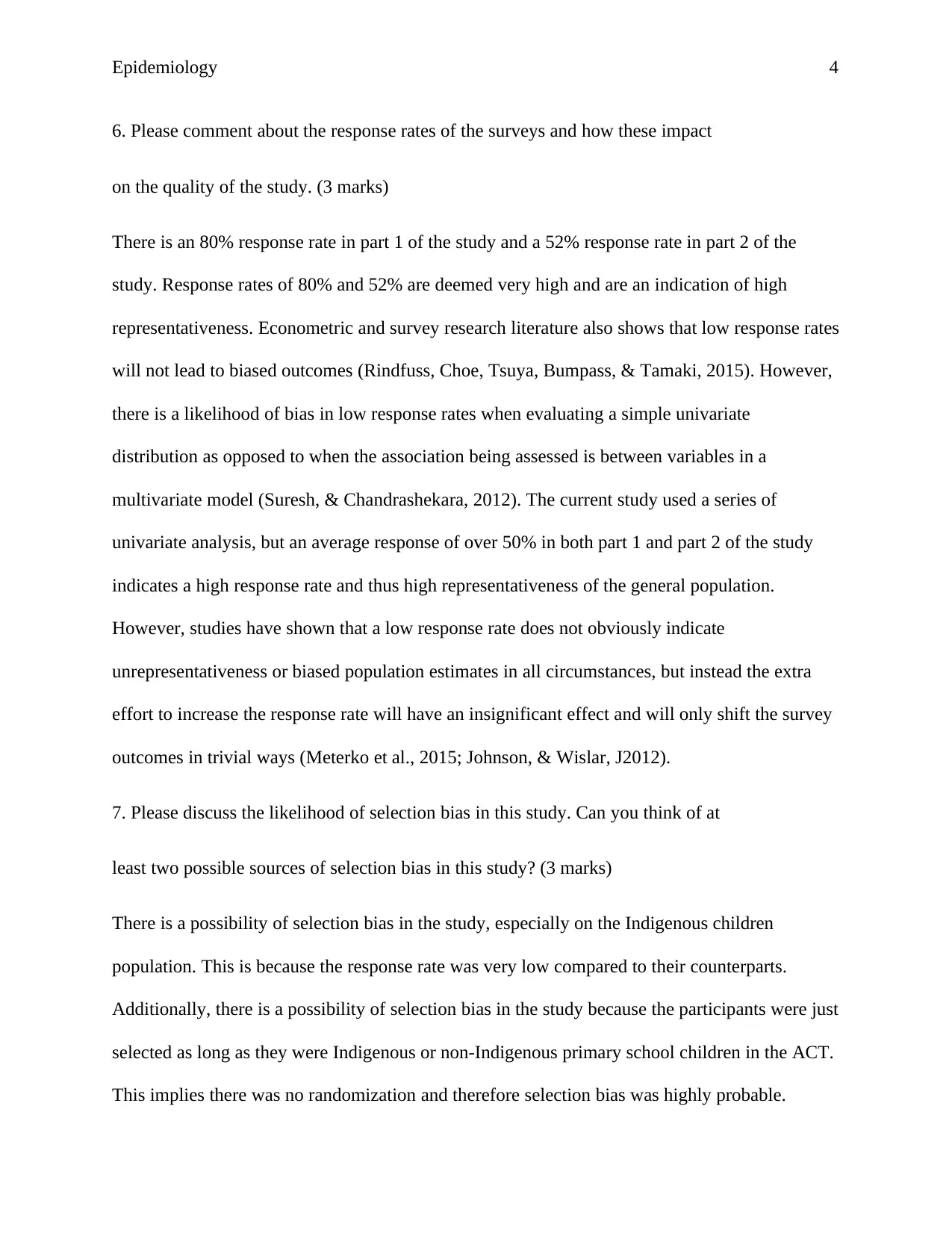
Epidemiology 4
6. Please comment about the response rates of the surveys and how these impact
on the quality of the study. (3 marks)
There is an 80% response rate in part 1 of the study and a 52% response rate in part 2 of the
study. Response rates of 80% and 52% are deemed very high and are an indication of high
representativeness. Econometric and survey research literature also shows that low response rates
will not lead to biased outcomes (Rindfuss, Choe, Tsuya, Bumpass, & Tamaki, 2015). However,
there is a likelihood of bias in low response rates when evaluating a simple univariate
distribution as opposed to when the association being assessed is between variables in a
multivariate model (Suresh, & Chandrashekara, 2012). The current study used a series of
univariate analysis, but an average response of over 50% in both part 1 and part 2 of the study
indicates a high response rate and thus high representativeness of the general population.
However, studies have shown that a low response rate does not obviously indicate
unrepresentativeness or biased population estimates in all circumstances, but instead the extra
effort to increase the response rate will have an insignificant effect and will only shift the survey
outcomes in trivial ways (Meterko et al., 2015; Johnson, & Wislar, J2012).
7. Please discuss the likelihood of selection bias in this study. Can you think of at
least two possible sources of selection bias in this study? (3 marks)
There is a possibility of selection bias in the study, especially on the Indigenous children
population. This is because the response rate was very low compared to their counterparts.
Additionally, there is a possibility of selection bias in the study because the participants were just
selected as long as they were Indigenous or non-Indigenous primary school children in the ACT.
This implies there was no randomization and therefore selection bias was highly probable.
6. Please comment about the response rates of the surveys and how these impact
on the quality of the study. (3 marks)
There is an 80% response rate in part 1 of the study and a 52% response rate in part 2 of the
study. Response rates of 80% and 52% are deemed very high and are an indication of high
representativeness. Econometric and survey research literature also shows that low response rates
will not lead to biased outcomes (Rindfuss, Choe, Tsuya, Bumpass, & Tamaki, 2015). However,
there is a likelihood of bias in low response rates when evaluating a simple univariate
distribution as opposed to when the association being assessed is between variables in a
multivariate model (Suresh, & Chandrashekara, 2012). The current study used a series of
univariate analysis, but an average response of over 50% in both part 1 and part 2 of the study
indicates a high response rate and thus high representativeness of the general population.
However, studies have shown that a low response rate does not obviously indicate
unrepresentativeness or biased population estimates in all circumstances, but instead the extra
effort to increase the response rate will have an insignificant effect and will only shift the survey
outcomes in trivial ways (Meterko et al., 2015; Johnson, & Wislar, J2012).
7. Please discuss the likelihood of selection bias in this study. Can you think of at
least two possible sources of selection bias in this study? (3 marks)
There is a possibility of selection bias in the study, especially on the Indigenous children
population. This is because the response rate was very low compared to their counterparts.
Additionally, there is a possibility of selection bias in the study because the participants were just
selected as long as they were Indigenous or non-Indigenous primary school children in the ACT.
This implies there was no randomization and therefore selection bias was highly probable.
Paraphrase This Document
Need a fresh take? Get an instant paraphrase of this document with our AI Paraphraser
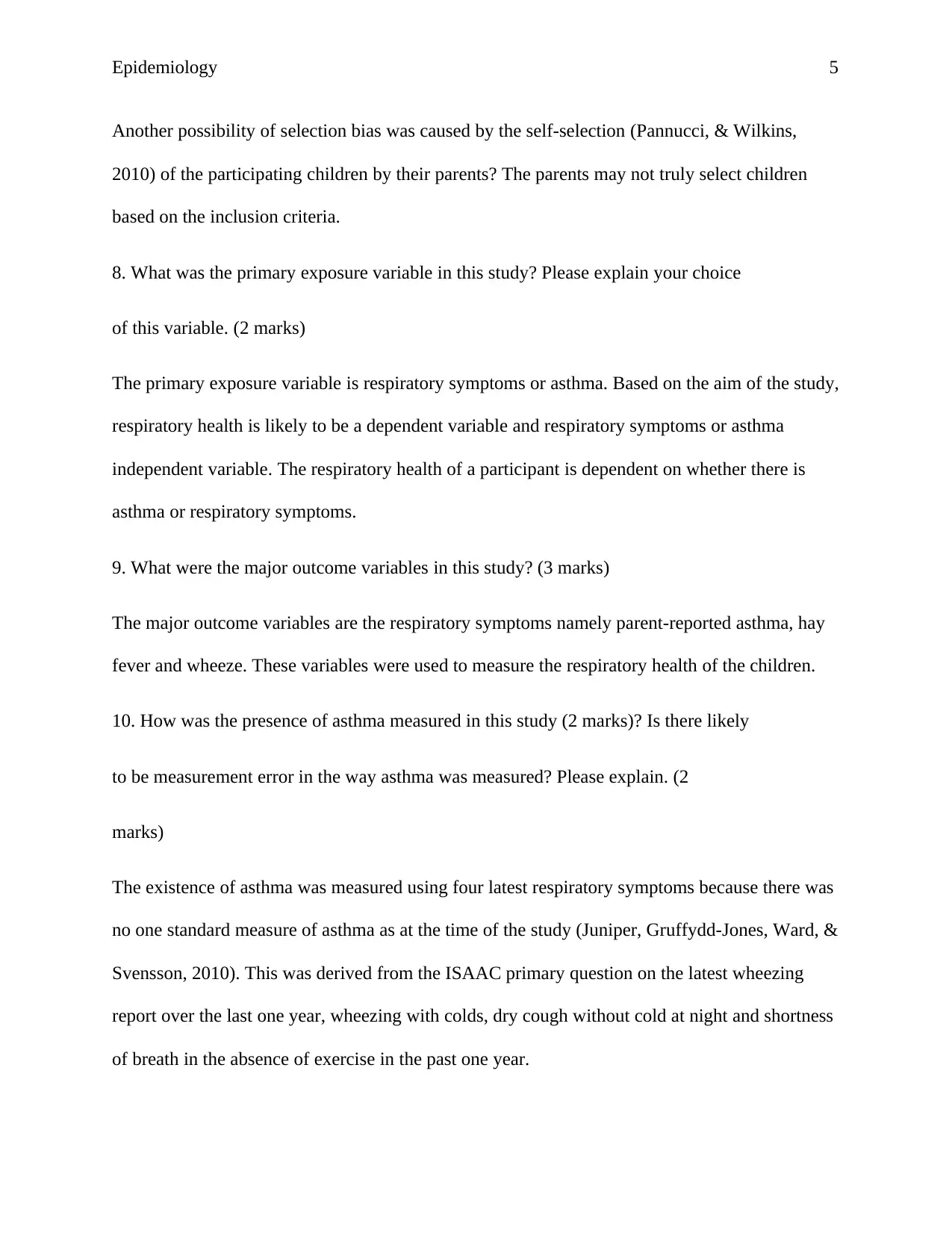
Epidemiology 5
Another possibility of selection bias was caused by the self-selection (Pannucci, & Wilkins,
2010) of the participating children by their parents? The parents may not truly select children
based on the inclusion criteria.
8. What was the primary exposure variable in this study? Please explain your choice
of this variable. (2 marks)
The primary exposure variable is respiratory symptoms or asthma. Based on the aim of the study,
respiratory health is likely to be a dependent variable and respiratory symptoms or asthma
independent variable. The respiratory health of a participant is dependent on whether there is
asthma or respiratory symptoms.
9. What were the major outcome variables in this study? (3 marks)
The major outcome variables are the respiratory symptoms namely parent-reported asthma, hay
fever and wheeze. These variables were used to measure the respiratory health of the children.
10. How was the presence of asthma measured in this study (2 marks)? Is there likely
to be measurement error in the way asthma was measured? Please explain. (2
marks)
The existence of asthma was measured using four latest respiratory symptoms because there was
no one standard measure of asthma as at the time of the study (Juniper, Gruffydd-Jones, Ward, &
Svensson, 2010). This was derived from the ISAAC primary question on the latest wheezing
report over the last one year, wheezing with colds, dry cough without cold at night and shortness
of breath in the absence of exercise in the past one year.
Another possibility of selection bias was caused by the self-selection (Pannucci, & Wilkins,
2010) of the participating children by their parents? The parents may not truly select children
based on the inclusion criteria.
8. What was the primary exposure variable in this study? Please explain your choice
of this variable. (2 marks)
The primary exposure variable is respiratory symptoms or asthma. Based on the aim of the study,
respiratory health is likely to be a dependent variable and respiratory symptoms or asthma
independent variable. The respiratory health of a participant is dependent on whether there is
asthma or respiratory symptoms.
9. What were the major outcome variables in this study? (3 marks)
The major outcome variables are the respiratory symptoms namely parent-reported asthma, hay
fever and wheeze. These variables were used to measure the respiratory health of the children.
10. How was the presence of asthma measured in this study (2 marks)? Is there likely
to be measurement error in the way asthma was measured? Please explain. (2
marks)
The existence of asthma was measured using four latest respiratory symptoms because there was
no one standard measure of asthma as at the time of the study (Juniper, Gruffydd-Jones, Ward, &
Svensson, 2010). This was derived from the ISAAC primary question on the latest wheezing
report over the last one year, wheezing with colds, dry cough without cold at night and shortness
of breath in the absence of exercise in the past one year.
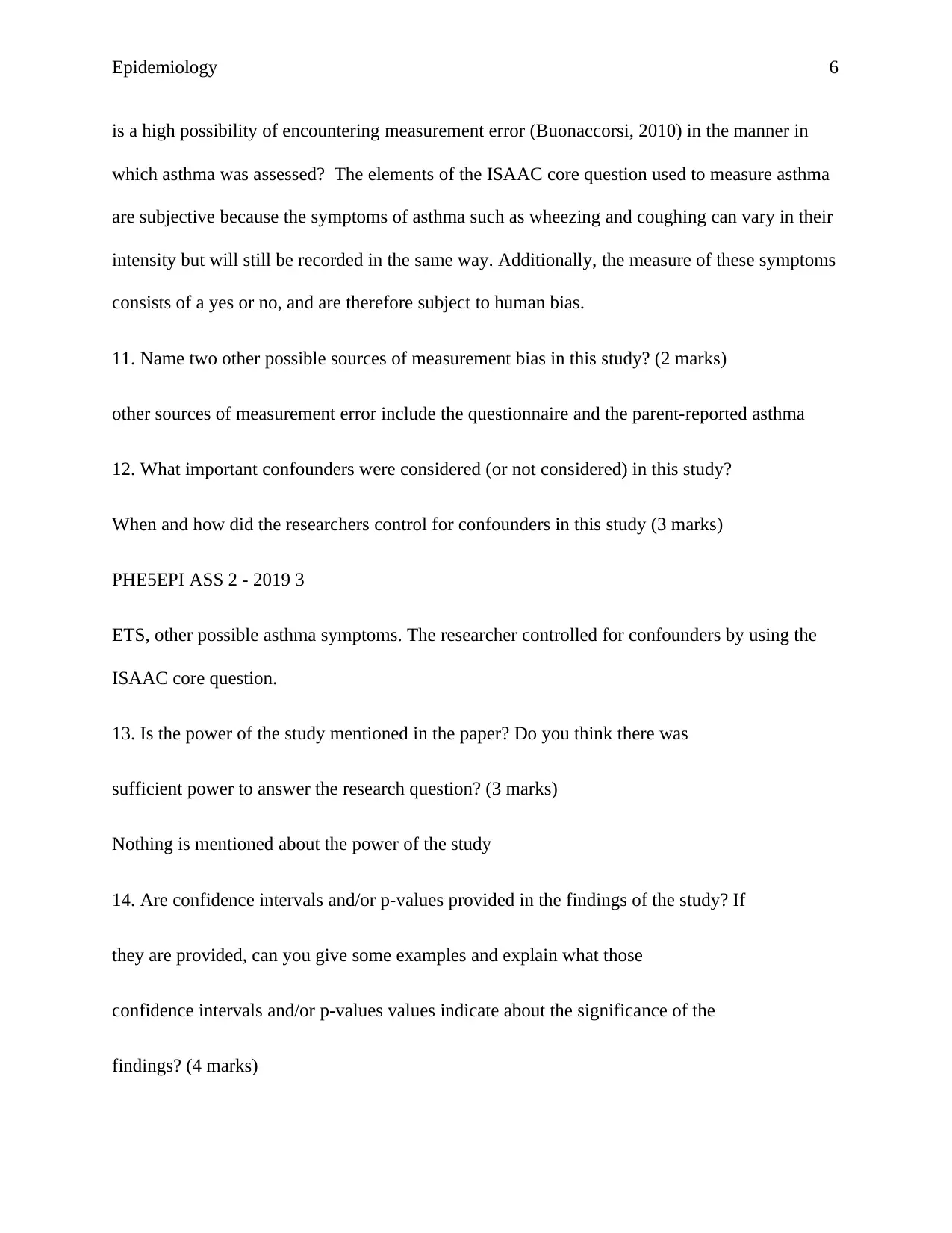
Epidemiology 6
is a high possibility of encountering measurement error (Buonaccorsi, 2010) in the manner in
which asthma was assessed? The elements of the ISAAC core question used to measure asthma
are subjective because the symptoms of asthma such as wheezing and coughing can vary in their
intensity but will still be recorded in the same way. Additionally, the measure of these symptoms
consists of a yes or no, and are therefore subject to human bias.
11. Name two other possible sources of measurement bias in this study? (2 marks)
other sources of measurement error include the questionnaire and the parent-reported asthma
12. What important confounders were considered (or not considered) in this study?
When and how did the researchers control for confounders in this study (3 marks)
PHE5EPI ASS 2 - 2019 3
ETS, other possible asthma symptoms. The researcher controlled for confounders by using the
ISAAC core question.
13. Is the power of the study mentioned in the paper? Do you think there was
sufficient power to answer the research question? (3 marks)
Nothing is mentioned about the power of the study
14. Are confidence intervals and/or p-values provided in the findings of the study? If
they are provided, can you give some examples and explain what those
confidence intervals and/or p-values values indicate about the significance of the
findings? (4 marks)
is a high possibility of encountering measurement error (Buonaccorsi, 2010) in the manner in
which asthma was assessed? The elements of the ISAAC core question used to measure asthma
are subjective because the symptoms of asthma such as wheezing and coughing can vary in their
intensity but will still be recorded in the same way. Additionally, the measure of these symptoms
consists of a yes or no, and are therefore subject to human bias.
11. Name two other possible sources of measurement bias in this study? (2 marks)
other sources of measurement error include the questionnaire and the parent-reported asthma
12. What important confounders were considered (or not considered) in this study?
When and how did the researchers control for confounders in this study (3 marks)
PHE5EPI ASS 2 - 2019 3
ETS, other possible asthma symptoms. The researcher controlled for confounders by using the
ISAAC core question.
13. Is the power of the study mentioned in the paper? Do you think there was
sufficient power to answer the research question? (3 marks)
Nothing is mentioned about the power of the study
14. Are confidence intervals and/or p-values provided in the findings of the study? If
they are provided, can you give some examples and explain what those
confidence intervals and/or p-values values indicate about the significance of the
findings? (4 marks)
⊘ This is a preview!⊘
Do you want full access?
Subscribe today to unlock all pages.

Trusted by 1+ million students worldwide
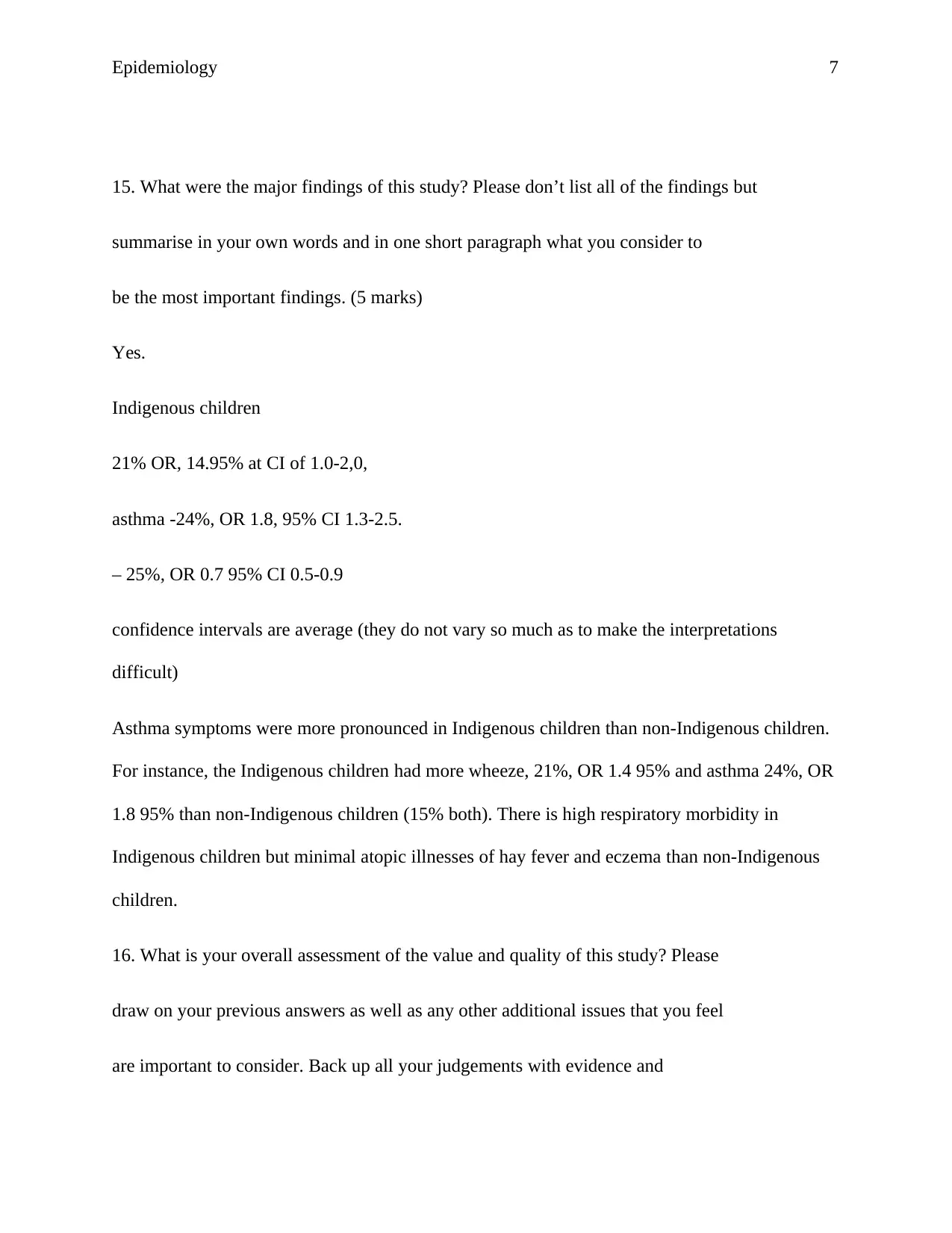
Epidemiology 7
15. What were the major findings of this study? Please don’t list all of the findings but
summarise in your own words and in one short paragraph what you consider to
be the most important findings. (5 marks)
Yes.
Indigenous children
21% OR, 14.95% at CI of 1.0-2,0,
asthma -24%, OR 1.8, 95% CI 1.3-2.5.
– 25%, OR 0.7 95% CI 0.5-0.9
confidence intervals are average (they do not vary so much as to make the interpretations
difficult)
Asthma symptoms were more pronounced in Indigenous children than non-Indigenous children.
For instance, the Indigenous children had more wheeze, 21%, OR 1.4 95% and asthma 24%, OR
1.8 95% than non-Indigenous children (15% both). There is high respiratory morbidity in
Indigenous children but minimal atopic illnesses of hay fever and eczema than non-Indigenous
children.
16. What is your overall assessment of the value and quality of this study? Please
draw on your previous answers as well as any other additional issues that you feel
are important to consider. Back up all your judgements with evidence and
15. What were the major findings of this study? Please don’t list all of the findings but
summarise in your own words and in one short paragraph what you consider to
be the most important findings. (5 marks)
Yes.
Indigenous children
21% OR, 14.95% at CI of 1.0-2,0,
asthma -24%, OR 1.8, 95% CI 1.3-2.5.
– 25%, OR 0.7 95% CI 0.5-0.9
confidence intervals are average (they do not vary so much as to make the interpretations
difficult)
Asthma symptoms were more pronounced in Indigenous children than non-Indigenous children.
For instance, the Indigenous children had more wheeze, 21%, OR 1.4 95% and asthma 24%, OR
1.8 95% than non-Indigenous children (15% both). There is high respiratory morbidity in
Indigenous children but minimal atopic illnesses of hay fever and eczema than non-Indigenous
children.
16. What is your overall assessment of the value and quality of this study? Please
draw on your previous answers as well as any other additional issues that you feel
are important to consider. Back up all your judgements with evidence and
Paraphrase This Document
Need a fresh take? Get an instant paraphrase of this document with our AI Paraphraser
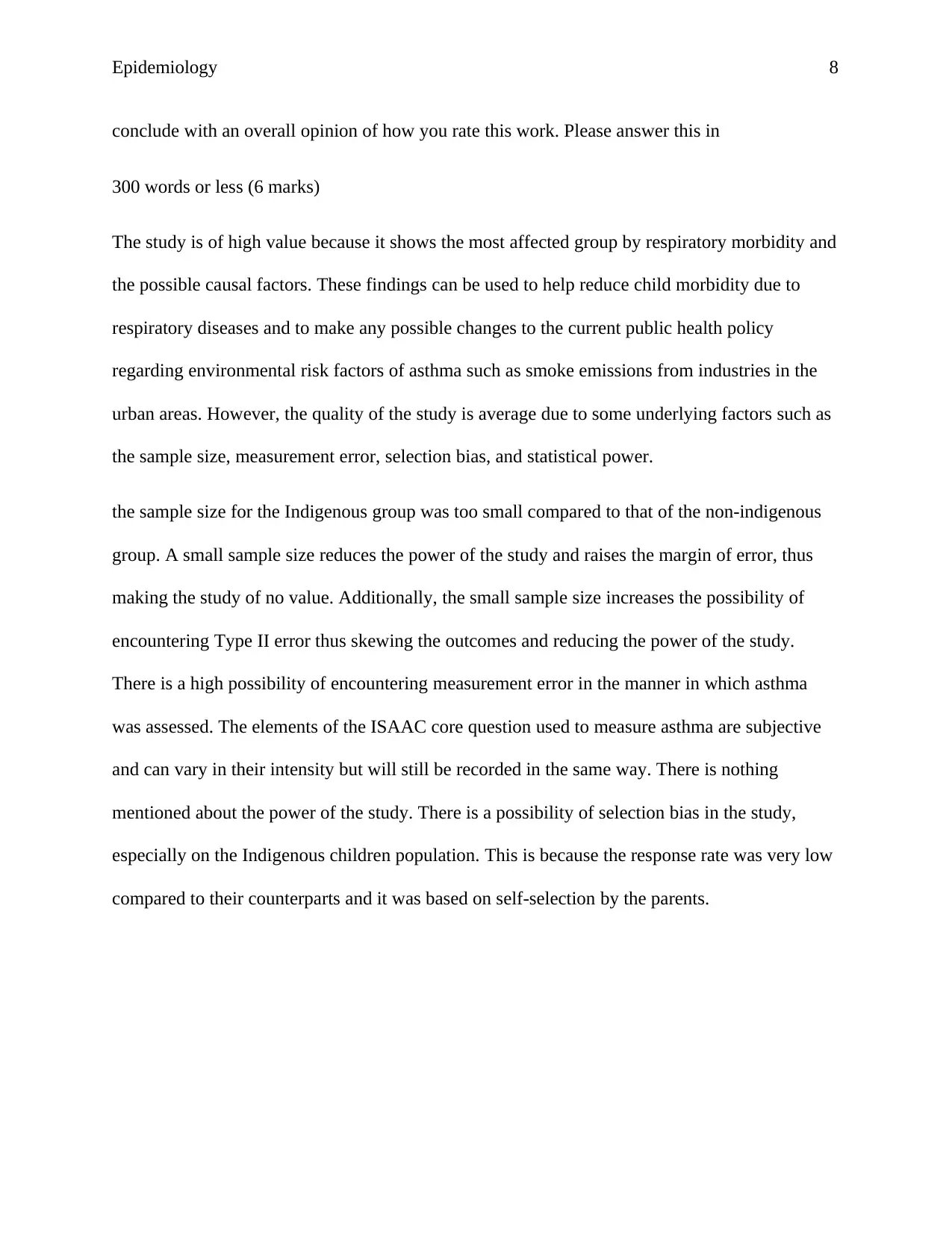
Epidemiology 8
conclude with an overall opinion of how you rate this work. Please answer this in
300 words or less (6 marks)
The study is of high value because it shows the most affected group by respiratory morbidity and
the possible causal factors. These findings can be used to help reduce child morbidity due to
respiratory diseases and to make any possible changes to the current public health policy
regarding environmental risk factors of asthma such as smoke emissions from industries in the
urban areas. However, the quality of the study is average due to some underlying factors such as
the sample size, measurement error, selection bias, and statistical power.
the sample size for the Indigenous group was too small compared to that of the non-indigenous
group. A small sample size reduces the power of the study and raises the margin of error, thus
making the study of no value. Additionally, the small sample size increases the possibility of
encountering Type II error thus skewing the outcomes and reducing the power of the study.
There is a high possibility of encountering measurement error in the manner in which asthma
was assessed. The elements of the ISAAC core question used to measure asthma are subjective
and can vary in their intensity but will still be recorded in the same way. There is nothing
mentioned about the power of the study. There is a possibility of selection bias in the study,
especially on the Indigenous children population. This is because the response rate was very low
compared to their counterparts and it was based on self-selection by the parents.
conclude with an overall opinion of how you rate this work. Please answer this in
300 words or less (6 marks)
The study is of high value because it shows the most affected group by respiratory morbidity and
the possible causal factors. These findings can be used to help reduce child morbidity due to
respiratory diseases and to make any possible changes to the current public health policy
regarding environmental risk factors of asthma such as smoke emissions from industries in the
urban areas. However, the quality of the study is average due to some underlying factors such as
the sample size, measurement error, selection bias, and statistical power.
the sample size for the Indigenous group was too small compared to that of the non-indigenous
group. A small sample size reduces the power of the study and raises the margin of error, thus
making the study of no value. Additionally, the small sample size increases the possibility of
encountering Type II error thus skewing the outcomes and reducing the power of the study.
There is a high possibility of encountering measurement error in the manner in which asthma
was assessed. The elements of the ISAAC core question used to measure asthma are subjective
and can vary in their intensity but will still be recorded in the same way. There is nothing
mentioned about the power of the study. There is a possibility of selection bias in the study,
especially on the Indigenous children population. This is because the response rate was very low
compared to their counterparts and it was based on self-selection by the parents.
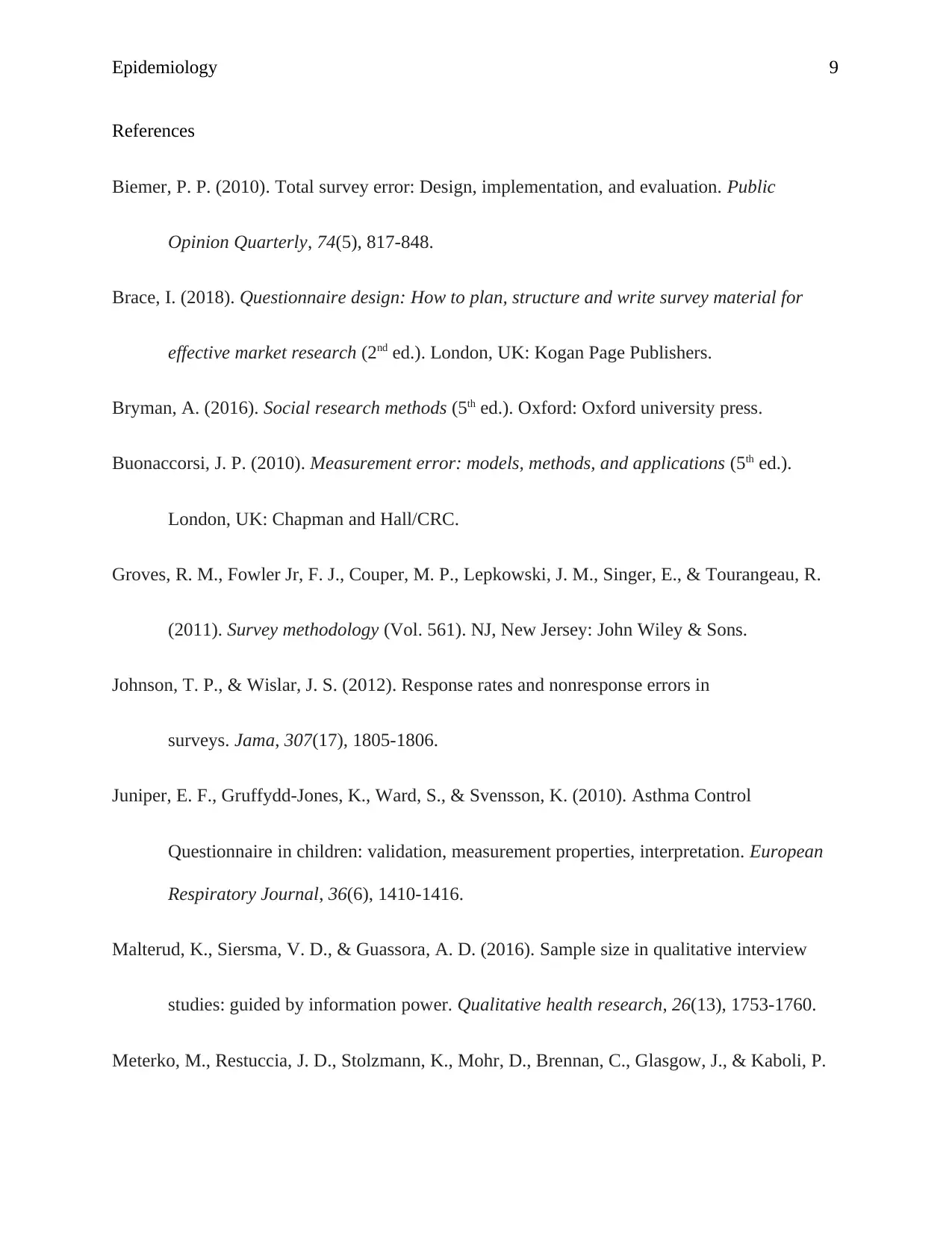
Epidemiology 9
References
Biemer, P. P. (2010). Total survey error: Design, implementation, and evaluation. Public
Opinion Quarterly, 74(5), 817-848.
Brace, I. (2018). Questionnaire design: How to plan, structure and write survey material for
effective market research (2nd ed.). London, UK: Kogan Page Publishers.
Bryman, A. (2016). Social research methods (5th ed.). Oxford: Oxford university press.
Buonaccorsi, J. P. (2010). Measurement error: models, methods, and applications (5th ed.).
London, UK: Chapman and Hall/CRC.
Groves, R. M., Fowler Jr, F. J., Couper, M. P., Lepkowski, J. M., Singer, E., & Tourangeau, R.
(2011). Survey methodology (Vol. 561). NJ, New Jersey: John Wiley & Sons.
Johnson, T. P., & Wislar, J. S. (2012). Response rates and nonresponse errors in
surveys. Jama, 307(17), 1805-1806.
Juniper, E. F., Gruffydd-Jones, K., Ward, S., & Svensson, K. (2010). Asthma Control
Questionnaire in children: validation, measurement properties, interpretation. European
Respiratory Journal, 36(6), 1410-1416.
Malterud, K., Siersma, V. D., & Guassora, A. D. (2016). Sample size in qualitative interview
studies: guided by information power. Qualitative health research, 26(13), 1753-1760.
Meterko, M., Restuccia, J. D., Stolzmann, K., Mohr, D., Brennan, C., Glasgow, J., & Kaboli, P.
References
Biemer, P. P. (2010). Total survey error: Design, implementation, and evaluation. Public
Opinion Quarterly, 74(5), 817-848.
Brace, I. (2018). Questionnaire design: How to plan, structure and write survey material for
effective market research (2nd ed.). London, UK: Kogan Page Publishers.
Bryman, A. (2016). Social research methods (5th ed.). Oxford: Oxford university press.
Buonaccorsi, J. P. (2010). Measurement error: models, methods, and applications (5th ed.).
London, UK: Chapman and Hall/CRC.
Groves, R. M., Fowler Jr, F. J., Couper, M. P., Lepkowski, J. M., Singer, E., & Tourangeau, R.
(2011). Survey methodology (Vol. 561). NJ, New Jersey: John Wiley & Sons.
Johnson, T. P., & Wislar, J. S. (2012). Response rates and nonresponse errors in
surveys. Jama, 307(17), 1805-1806.
Juniper, E. F., Gruffydd-Jones, K., Ward, S., & Svensson, K. (2010). Asthma Control
Questionnaire in children: validation, measurement properties, interpretation. European
Respiratory Journal, 36(6), 1410-1416.
Malterud, K., Siersma, V. D., & Guassora, A. D. (2016). Sample size in qualitative interview
studies: guided by information power. Qualitative health research, 26(13), 1753-1760.
Meterko, M., Restuccia, J. D., Stolzmann, K., Mohr, D., Brennan, C., Glasgow, J., & Kaboli, P.
⊘ This is a preview!⊘
Do you want full access?
Subscribe today to unlock all pages.

Trusted by 1+ million students worldwide
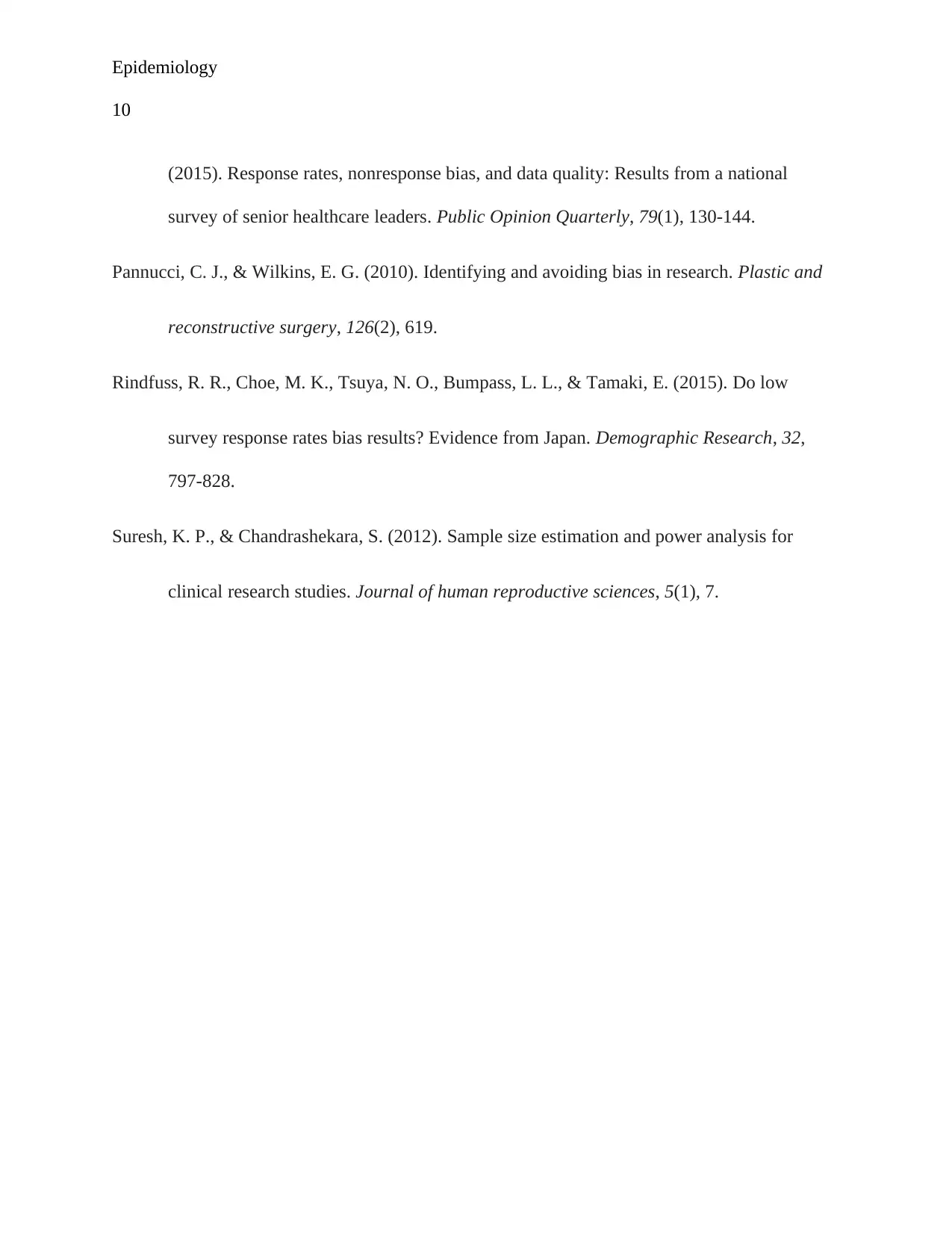
Epidemiology
10
(2015). Response rates, nonresponse bias, and data quality: Results from a national
survey of senior healthcare leaders. Public Opinion Quarterly, 79(1), 130-144.
Pannucci, C. J., & Wilkins, E. G. (2010). Identifying and avoiding bias in research. Plastic and
reconstructive surgery, 126(2), 619.
Rindfuss, R. R., Choe, M. K., Tsuya, N. O., Bumpass, L. L., & Tamaki, E. (2015). Do low
survey response rates bias results? Evidence from Japan. Demographic Research, 32,
797-828.
Suresh, K. P., & Chandrashekara, S. (2012). Sample size estimation and power analysis for
clinical research studies. Journal of human reproductive sciences, 5(1), 7.
10
(2015). Response rates, nonresponse bias, and data quality: Results from a national
survey of senior healthcare leaders. Public Opinion Quarterly, 79(1), 130-144.
Pannucci, C. J., & Wilkins, E. G. (2010). Identifying and avoiding bias in research. Plastic and
reconstructive surgery, 126(2), 619.
Rindfuss, R. R., Choe, M. K., Tsuya, N. O., Bumpass, L. L., & Tamaki, E. (2015). Do low
survey response rates bias results? Evidence from Japan. Demographic Research, 32,
797-828.
Suresh, K. P., & Chandrashekara, S. (2012). Sample size estimation and power analysis for
clinical research studies. Journal of human reproductive sciences, 5(1), 7.
1 out of 10
Related Documents
Your All-in-One AI-Powered Toolkit for Academic Success.
+13062052269
info@desklib.com
Available 24*7 on WhatsApp / Email
![[object Object]](/_next/static/media/star-bottom.7253800d.svg)
Unlock your academic potential
Copyright © 2020–2025 A2Z Services. All Rights Reserved. Developed and managed by ZUCOL.





